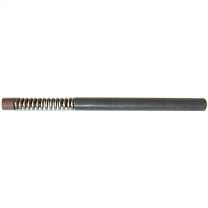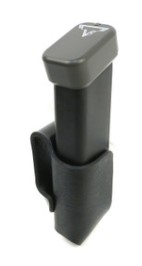Your cart is currently empty!
White Sound Defense HRED
$17.99
High Reliability Extractor Depressor (H.R.E.D.)™ Plunger Assembly for Glock pistols in .357 Sig / .40 S&W and 9mm.
Description
High Reliability Extractor Depressor (H.R.E.D.)™ Plunger Assembly for Glock pistols in .357 Sig / .40 S&W and 9mm. Works with Gen 4 Glocks. Note: the 9mm HRED does not work with the Glock 43.
The H.R.E.D. assembly comes with one extractor spring and is designed to increase extractor reliability under harsh operating conditions or when employing poor quality ammunition. It accomplishes this by redistributing mass so that the movement of the slide assists the plunger, rather than fighting against it. The components are machined from a corrosion resistant stainless steel and include a White Sound Defense heavy duty extractor spring to further ensure reliable function. The H.R.E.D. is compatible with both 3rd and 4th generation pistols.
Extractors:
This product should be used with a Loaded Chamber Indicator (LCI) style extractor.
Installation Note:
The short solid end is inserted first into the rear of the slide. When installed correctly the short solid end will be in contact with the extractor and the longer solid end will be touching the slide cover plate. This is opposite in appearance to the stock assembly.
Detailed Information:
The most obvious difference between the H.R.E.D. and the stock assembly is that the longer part of the mechanism is located at the rear of the H.R.E.D. assembly rather than at the front as with the stock design. In the stock design the longer part is the extractor plunger which transfers force to the extractor itself. In the H.R.E.D. the longer part is a stand-off bar which serves to relocate the spring toward the front of the firearm and serves to provide mass to the rear of the spring.
In the stock design the vast majority of mass is located forward (toward the muzzle) of the spring. In the H.R.E.D. the majority of mass is located to the rear of the spring. This change in mass distribution ratio is further increased by the geometry of the stand-off bar. The stand-off bar maintains its maximum diameter for its entire length in order to maximize the mass of the bar.
The most significant reason for this mass relocation is to reduce to the effect that recoil has on extractor function. Once the bullet and propellant gases have exited the barrel the slide begins to decelerate. This deceleration causes free mass in the slide (extractor assembly, firing pin, etc) to exert reward pressure on the slide. Said another way, as the slide decelerates, free masses in the slide will press against the rear of the slide just as a person presses into their seatbelt during sudden braking.
In the stock design this deceleration causes de-loading of the extractor. The deceleration in a recoiling firearm is not generally smooth and tends to sharpen at several key points prior to extraction:
First, when the recoiling barrel makes contact with the locking block.
Second, when the barrel first starts to unlock and the extractor shifts on the cartridge rim
Third, when the barrel binds in the locking block and the extractor attempts to dislodge the cartridge
At each of these points, any mass forward of the extractor spring will apply compressive force (rearward force) to the spring and reduce the pressure on the extractor. In other words, the mass of the extractor depressor is thrown toward the rear of the firearm away from the extractor as the slide decelerates. As there are significant G-forces involved, the mass of the extractor depressor is multiplied many times. This is why it is critical to keep the mass forward of the spring relatively low.
This compressive force on the extractor spring is further exacerbated by anything that increases the frame’s resistance to movement as this increases the rate of deceleration in the slide. Put simply, the harder the frame is to move, the more quickly the slide will come to a stop. This means the addition of mass such as tactical lights or metal guide-rods all result in reduced extractor effectiveness. The effect is also more pronounced with very experienced shooters who take a very high, very firm grip on the weapon. In the case of aftermarket metal frames the difference is even more pronounced.
Also, by redesigning for a lighter sprung mass the system is able to keep tension on the extractor longer and returns tension sooner during vibrations that occur during operation of the pistol. The reason for this being the frequency of rebound is increased for the extractor depressor.
The next major difference in design is the overall mass of the system. The mass of the H.R.E.D. assembly is designed to be higher than the stock system which provides an advantage to extraction during the acceleration phase of the slide’s movement. During acceleration, additional pressure is exerted on the extractor as the mass of the entire assembly bears on the extractor. The higher the mass the more force is applied. Again the significant G forces involved greatly magnify differences in mass. This additional force on the extractor increases the likelihood of the extractor being fully seated before extraction phase begins. It also allows the extractor to more fully ‘bite’ the softer bass of the cartridge and displace fouling.
In short, during the rearward movement of the slide you want high mass when the slide is accelerating and low mass when the slide is decelerating. The H.R.E.D. approximates this by changing where the mass sits in relation to the spring.
However, in order to fully take advantage of the modified mass distribution several design issues had to be overcome. The stock assembly relies largely on the length of the extractor depressor bar to keep it aligned so that it doesn’t bind in its raceway. Using a shorter lighter extractor depressor bearing meant that some other method of preventing binding had to be found.
Several design features were added to facilitate functioning of the new shorter depressor bearing:
First, the length of the bearing nose (thickest part) was increased slightly to provide greater resistance to canting.
Second, the diameter of the spring retention section of the bearing spring guide adjusted to ensure that the first coil of the spring which is wound around the bearing has a slightly greater diameter than the bearing diameter. As a result the first coil of the spring makes solid contact with the raceway. This effectively lengthens the nose of the bearing (reducing canting) without adding mass. This also shields the sharp edge of the bearing seat from the raceway.
And finally, the geometry of the spring guide was designed to limit canting to around 1 degree, so even if other measures fail the spring itself will hold the bearing in the proper position.
There are several additional minor design features that are intended to further ensure reliability. A few examples would be:
The total length of the combined spring guides is set to provide rigid support and protect the spring from deformation should it be compressed to the point of coil-bind.
The rear of the stand-off bar is slightly radiused to reduce point loading on the slide cover plate.
Material selection is also tailored for reliability, such as stainless steel of the appropriate grade and heat treatment.
Aside from the machined parts a new spring was designed for the assembly. The new spring is fairly similar in design to the stock spring with a few key differences. A stainless spring wire is used to reduce the likelihood of a sudden spring failure resulting from corrosion or pitting. Additionally, the spring rate was increased slightly to further ensure reliable extraction.
The H.R.E.D. assembly is compatible with a stock Glock plunger spring. It is recommended that only springs with flat ground ends be used with either the stock or H.R.E.D assembly. Any spring that does not have its ends ground flat will show additional side flex may exhibit buckling and rub against the sides of the raceway making it more difficult for the spring to do its job properly.
This assembly currently has a pending patent application.
![]()
FAQ
Q: Can I use the OEM extractor spring with the rest of the H.R.E.D. assembly?
A: Yes, you can use the OEM spring. However, no other parts are interchangeable with the stock assembly.
Q: Does the H.R.E.D. work with all generations of Glock pistols?
A: Yes, it has been tested extensively with pistols up to and including Gen 4. However, we do recommend use of a LCI extractor in all cases.
Q: Will the H.R.E.D. fix my extraction problem?
A. Possibly. The H.R.E.D. was designed to improve reliability in extreme environments and we believe it does this job very well. That said, Glock pistols are well engineered, so if you have one that will not function with OEM components, something is out of tolerance. The root issue should be identified, even if installing the H.R.E.D. resolves the problem. Works with Gen 4 pistols.
Additional information
| Weight | 3 oz |
|---|---|
| Select Product Desired | 9mm, .40 S&W/.357 Sig |






